The project is to establish a factory for manufacturing nails, screws and nuts. The factory produces and manufactures nails, screws and nuts in different sizes, shapes and dimensions, which are used in the construction sector (construction and contracting companies), the furniture and wood products industry and furniture workshops. The demand for nails, screws and nuts is characterized by increase and continuity, which has led to an increase in demand for industries that serve the construction sector. Therefore, establishing a factory for producing nails, screws and nuts is considered one of the great investment opportunities that achieve high economic returns compared to other projects. By preparing a feasibility study for the nails, screws and nuts factory project, it becomes clear that the project is one of the investment opportunities with appropriate costs that achieve high economic returns.

mashroo3k Company for Feasibility Studies and Business Plans prepares a feasibility study for a nail, screw and nut factory project from the marketing, technical and financial aspects. After the company studies the main idea of the project, its components and nature, studies the competitors, target markets and the marketing gap between supply and demand, and analyzes the market size, it becomes clear that there is an urgent need for the project products, which are: (Stud bolts, heavy hex nuts & hex bolts – Anchor bolts with 2 hex nuts – Washers and others – nails / screws / nuts). <The factory aims to employ workers, improve their economic and social level, achieve a high quality level for the factory’s products, and maintain a competitive price level that enables the project to obtain its target share and contribute to covering part of the increasing demand for nails, screws and nuts. The factory’s products are characterized by strength, solidity, availability of high-quality raw materials, use of the latest advanced production technology, availability of a variety of products and other features. The project seeks to take maximum advantage of the increased demand for products in the target markets (construction and building sector – furniture and wood products manufacturing sector and furniture manufacturing workshops), and it also seeks to acquire the largest possible percentage of the marketing gap.




The Kingdom of Saudi Arabia has paved the way for development with its ambitious Vision 2030, which aims at economic diversification, the renaissance of non-oil sectors and increasing the contribution of the private sector to GDP, and this can only be achieved through the renaissance of industry and mining as two main tributaries in major economies, and the Kingdom is determined to increase their participation in its GDP by about 15%. When talking about industry in the Kingdom, it should be noted that it was not born out of the moment, but rather it has been extended and rooted since the discovery of oil in the Kingdom in the late thirties of the last century. Over the decades, the Kingdom spared no effort to develop its industry; it established the Industrial Development Fund (1974), the Royal Commission for Jubail and Yanbu (1975), and SABIC in 1976. The roles and tasks undertaken by these institutions and the programs they worked on to grow the industrial sector and develop its performance and working mechanisms are no secret to anyone. As a result of the efforts exerted years ago in this direction, the number of factories in the Kingdom today has increased to more than 10,000 factories. We, mashroo3k, believe in the importance of the industrial sector and its role in driving the economy, so we will present its most important indicators below so that anyone wishing to invest in it can be aware of them:
